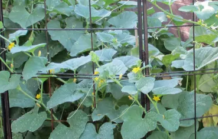As the days get longer and warmer, many gardeners are itching to get into the garden. But it’s important to resist this temptation until the soil is ready.
“We can very quickly lose years of building soil structure if we work the soil when it’s too wet,” said David Trinklein, horticulture specialist for University of Missouri Extension.
Soil that’s turned over when it’s wet will form clods that will be very difficult to break apart later. This is because wet soil is more easily compacted than dry soil. Trinklein recommends that you do the “baseball test” before you start digging.
“Take up a sample of soil and form it into a ball about the size of baseball,” he said.
Then put the soil ball in the palm of one hand and sharply strike it with the heel of the other hand.
“If you see the imprint of your hand in the ball, the soil is too wet to work,” Trinklein said. “If the ball crumbles when you hit it, go for it. It’s not going to get any better.”
Another practice that can destroy soil structure is excessive mechanical tillage, Trinklein said. You see rotary tillers lined up shiny and new at most garden stores at this time of the year. After purchasing one, the temptation to use a new tiller is great.
“We worry about gardeners beating their soil to death with their rotary tillers,” he said. “Yes, you must prepare a good seed bed, and rotary tillers are great for that, but don’t beat the soil to the point of destroying soil structure that you worked long and hard to help create.”
Trinklein recommends minimum tillage: Once the bed is established, you no longer disturb the soil surface. Instead, use mulch for weed control, water conservation and adding organic matter to the soil.
The other caution has to do with compost produced from animal manure, Trinklein said. Compost is an inexpensive way to add valuable organic matter to the soil. However, for the past few years compost has been discovered contaminated with herbicides that do not break down when they travel through an animal’s digestive system.
Farmers use these herbicides to control weeds in pastures and hayfields. Unfortunately, sensitive crops such as tomatoes react badly to even tiny amounts of these herbicides. If contaminated compost is worked into garden soil, it can take years before the contamination subsides enough that sensitive crops are not affected, he said.
To avoid this, test all compost made from animal waste before adding it to garden soil. The test simply involves planting green bean seeds in a container filled with the compost and waiting to see the health of those seedlings, Trinklein said. If, within a week to 10 days after emergence, they develop twisted, malformed foliage, the compost likely is contaminated and should not be used in gardens where sensitive crops will be grown.
“We are warning people to be careful and to test compost with the ‘green bean’ test,” Trinklein said. “The worst thing that could happen from this recent phenomenon is for people to stop using compost in their gardens. We just want to make sure the compost is safe.”
While you’re waiting for the soil to be ready, you can soothe your gardening itch by sketching out garden plans and browsing gardening catalogs so you’ll be ready when the soil is ready.
For more information, see the MU Extension publication “Soils, Plant Nutrition and Nutrient Management” (MG4), available for free download at http://extension.missouri.edu/p/MG4.




